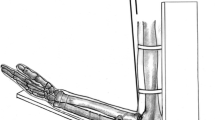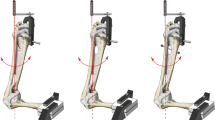Abstract
Purpose
We hypothesized that the re-fixation of the deep and superficial fibres of the distal radioulnar ligaments provide improved stability compared to reconstruction of the deep fibres alone.
Methods
Fourteen fresh-frozen cadaver upper extremities were used for biomechanical testing. Transosseous re-fixation of the deep fibres of the distal radioulnar ligaments alone (single mattress suture group; n = 7) was compared to the transosseous re-attachment of the deep and superficial fibres (double mattress suture group; n = 7). Cyclic load application provoked palmar translation of the radius with respect to the rigidly affixed ulna. Creep, stiffness, and hysteresis were obtained from the load-deformation curves, respectively. Testing was done in neutral forearm rotation, 60° pronation, and 60° supination.
Results
The re-fixation techniques did not differ significantly regarding the viscoelastic parameters creep, hysteresis, and stiffness. Several significant differences of one cycle to the consecutive one within each re-fixation group could be detected especially for creep and hysteresis. No significant differences between the different forearm positions could be detected for each viscoelastic parameter.
Conclusions
The re-fixation techniques did not differ significantly regarding creep, hysteresis, and stiffness. This means that the additional re-attachment of the superficial fibres may not provide greater stability to the DRUJ. Bearing in mind that the study was a cadaver examination with a limited number of specimens we may suppose that the re-attachment of the superficial fibres seem to be unnecessary. A gradual decline of creep and hysteresis from first to last loading-unloading cycle is to be expected and typical of ligaments which are viscoelastic.



Similar content being viewed by others
References
Hagert CG (1994) Distal radius fracture and the distal radioulnar joint--anatomical considerations. Handchir Mikrochir Plast Chir 26:22–26
Kleinman WB (2007) Stability of the distal radioulna joint: biomechanics, pathophysiology, physical diagnosis, and restoration of function what we have learned in 25 years. J Hand Surg [Am] 32:1086–1106. doi:10.1016/j.jhsa.2007.06.014
Spies CK, Müller LP, Oppermann J et al (2014) Instability of the distal radioulnar joint - an overview of clinical and radiological procedures regarding their efficacies. Handchir Mikrochir Plast Chir 46:137–150. doi:10.1055/s-0033-1363662
Haugstvedt J, Berger RA, Nakamura T et al (2006) Relative contributions of the ulnar attachments of the triangular fibrocartilage complex to the dynamic stability of the distal radioulnar joint. J Hand Surg [Am] 31:445–451. doi:10.1016/j.jhsa.2005.11.008
Xu J, Tang JB (2009) In vivo changes in lengths of the ligaments stabilizing the distal radioulnar joint. J Hand Surg [Am] 34:40–45. doi:10.1016/j.jhsa.2008.08.006
Schuind F, An KN, Berglund L et al (1991) The distal radioulnar ligaments: a biomechanical study. J Hand Surg [Am] 16:1106–1114
Moritomo H (2015) Open repair of the triangular fibrocartilage complex from palmar aspect. J Wrist Surg 4:2–8. doi:10.1055/s-0034-1398474
Nakamura T, Takayama S, Horiuchi Y et al (2001) Origins and insertions of the triangular fibrocartilage complex: a histological study. J Hand Surg (Br) 26:446–454. doi:10.1054/jhsb.2001.0562
Moriya T, Aoki M, Iba K et al (2009) Effect of triangular ligament tears on distal radioulnar joint instability and evaluation of three clinical tests: a biomechanical study. J Hand Surg Eur Vol 34:219–223. doi:10.1177/1753193408098482
Haugstvedt J, Berger RA, Berglund LJ et al (2002) An analysis of the constraint properties of the distal radioulnar ligament attachments to the ulna. J Hand Surg [Am] 27:61–67
Hagert E, Hagert C (2010) Understanding stability of the distal radioulnar joint through an understanding of its anatomy. Hand Clin 26:459–466. doi:10.1016/j.hcl.2010.05.002
Gofton WT, Gordon KD, Dunning CE et al (2004) Soft-tissue stabilizers of the distal radioulnar joint: an in vitro kinematic study. J Hand Surg [Am] 29:423–431. doi:10.1016/j.jhsa.2004.01.020
Petersen MS, Adams BD (1993) Biomechanical evaluation of distal radioulnar reconstructions. J Hand Surg [Am] 18:328–334. doi:10.1016/0363-5023(93)90370-I
Atzei A, Luchetti R, Braidotti F (2015) Arthroscopic foveal repair of the triangular fibrocartilage complex. J Wrist Surg 4:22–30. doi:10.1055/s-0035-1544226
Farr S, Zechmann U, Ganger R et al (2015) Clinical experience with arthroscopically-assisted repair of peripheral triangular fibrocartilage complex tears in adolescents-technique and results. Int Orthop. doi:10.1007/s00264-015-2795-6
Iwasaki N, Nishida K, Motomiya M et al (2011) Arthroscopic-assisted repair of avulsed triangular fibrocartilage complex to the fovea of the ulnar head: a 2- to 4-year follow-up study. Arthroscopy 27:1371–1378. doi:10.1016/j.arthro.2011.05.020
Iwasaki N, Minami A (2009) Arthroscopically assisted re-attachment of avulsed triangular fibrocartilage complex to the fovea of the ulnar head. J Hand Surg [Am] 34:1323–1326. doi:10.1016/j.jhsa.2009.02.026
Atzei A (2009) New trends in arthroscopic management of type 1-B TFCC injuries with DRUJ instability. J Hand Surg Eur Vol 34:582–591. doi:10.1177/1753193409100120
Nakamura T, Nakao Y, Ikegami H et al (2004) Open repair of the ulnar disruption of the triangular fibrocartilage complex with double three-dimensional mattress suturing technique. Tech Hand Up Extrem Surg 8:116–123. doi:10.1097/01.bth.0000126573.05697.29
Martineau PA, Bergeron S, Beckman L et al (2005) Reconstructive procedure for unstable radial-sided triangular fibrocartilage complex avulsions. J Hand Surg [Am] 30:727–732. doi:10.1016/j.jhsa.2005.01.006
Chou KH, Sarris IK, Sotereanos DG (2003) Suture anchor repair of ulnar-sided triangular fibrocartilage complex tears. J Hand Surg (Br) 28:546–550
Spies CK, Müller LP, Unglaub F et al (2014) Anatomical transosseous fixation of the deep and superficial fibres of the radioulnar ligaments. Arch Orthop Trauma Surg 134:1783–1788. doi:10.1007/s00402-014-2103-8.
Garcia-Elias M, Smith DE, Llusá M (2003) Surgical approach to the triangular fibrocartilage complex. Tech Hand Up Extrem Surg 7:134–140
Garcia-Elias M (2012) Clinical examination of the ulnar-sided painful wrist. In: del Piñal F (ed) Arthroscopic management of ulnar pain. Springer Berlin Heidelberg; Imprint: Springer, Berlin, Heidelberg, pp 25–44
Dy CJ, Ouellette EA, Makowski AH et al (2012) Peripheral triangular fibrocartilage complex tears cause ulnocarpal instability: a biomechanical pilot study. Clin Orthop Relat Res 470:2771–2775. doi:10.1007/s11999-012-2399-z
af Ekenstam F, Hagert CG (1985) Anatomical studies on the geometry and stability of the distal radio ulnar joint. Scand J Plast Reconstr Surg 19:17–25
Werner FW, Taormina JL, Sutton LG et al (2011) Structural properties of 6 forearm ligaments. J Hand Surg [Am] 36:1981–1987. doi:10.1016/j.jhsa.2011.09.026
Pirela-Cruz MA, Goll SR, Klug M et al (1991) Stress computed tomography analysis of the distal radioulnar joint: a diagnostic tool for determining translational motion. J Hand Surg [Am] 16:75–82
Moritomo H, Kataoka T (2014) Palmar reconstruction of the triangular fibrocartilage complex for static instability of the distal radioulnar joint. Tech Hand Up Extrem Surg 18:110–115. doi:10.1097/BTH.0000000000000047
Acknowledgments
We thank Mr. Thomas Bruckner, PhD, Department of Medical Biometry and Informatics, Heidelberg, Germany for his statistical advice.
We thank Mrs. Jutta Knifka, Department of Orthopaedics and Traumatology, University Hospital Cologne, Germany, for her relentless support.
Special thanks to Mr. Martin Külser-Feldker, Institute of Biomechanics and Orthopaedics, German Sport University Cologne, Germany, for his great expertise.
Conflict of interest
The authors declare that they have no conflicts of interest.
Ethical approval
All procedures performed were in accordance with the ethical standards of the institutional ethics committee and with the 1964 Helsinki declaration.
Funding
The study was supported by a grant of the Richard and Annemarie Wolf Foundation. The first author appreciates the financial support kindly.
Author information
Authors and Affiliations
Corresponding author
Electronic supplementary material
Below is the link to the electronic supplementary material.
Fig. 4
a-b *Significantly (p < 0.05) different from the preceding cycle within the group (both groups: n = 7). c *Significantly (p < 0.05) different from the preceding cycle within the group (single mattress suture group: n = 7; double mattress suture group: n = 6) (DOCX 14 kb)
ESM 2
(DOCX 12 kb)
ESM 3
(DOCX 14 kb)
Fig. 5
a *Significantly (p < 0.05) different from the preceding cycle within the group (single mattress suture group: n = 7; double mattress suture group: n = 6). b-c *Significantly (p < 0.05) different from the preceding cycle within the group (both groups: n = 7) (DOCX 14 kb)
ESM 5
(DOCX 14 kb)
ESM 6
(DOCX 12 kb)
Fig. 6
a-c *Significantly (p < 0.05) different from the preceding cycle within the group (both groups: n = 7) (DOCX 14 kb)
ESM 8
(DOCX 14 kb)
ESM 9
(DOCX 12 kb)
Fig. 7
a-c *Significantly (p < 0.05) different from the preceding cycle within the group (all groups: n = 7) (DOCX 16 kb)
ESM 11
(DOCX 16 kb)
ESM 12
(DOCX 16 kb)
Fig. 8
a *Significantly (p < 0.05) different from the preceding cycle within the group (neutral: n = 7; pronation: n = 6; supination: n = 7). b *Significantly (p < 0.05) different from the preceding cycle within the group (all groups: n = 7). c *Significantly (p < 0.05) different from the preceding cycle within the group (neutral: n = 6; pronation: n = 7; supination: n = 7) (DOCX 16 kb)
ESM 14
(DOCX 16 kb)
ESM 15
(DOCX 15 kb)
Rights and permissions
About this article
Cite this article
Spies, C.K., Niehoff, A., Unglaub, F. et al. Biomechanical comparison of transosseous re-fixation of the deep fibres of the distal radioulnar ligaments versus deep and superficial fibres: a cadaver study. International Orthopaedics (SICOT) 40, 315–321 (2016). https://doi.org/10.1007/s00264-015-2986-1
Received:
Accepted:
Published:
Issue Date:
DOI: https://doi.org/10.1007/s00264-015-2986-1




